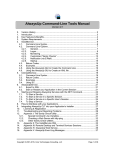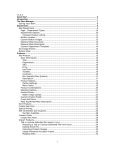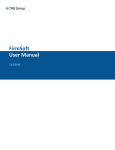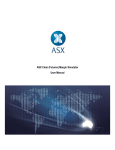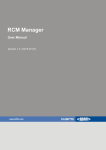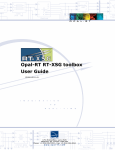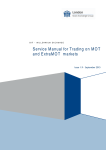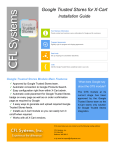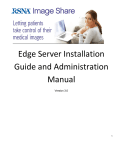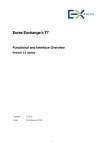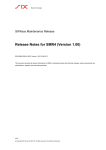Download Pre-Trade Risk Check Module User Manual
Transcript
Pre-Trade Risk Check Module User Manual Version 1.2 (2015-08-11) Pre-Trade Risk Check Module. User Manual Table of Contents Overview ....................................................................................................................................................................... 3 How to Configure Risk Check Module. Workflow ........................................................................................................ 3 Pre-Trade Risk Limits .................................................................................................................................................... 3 Account Level Limits ................................................................................................................................................. 4 User Level Limits ....................................................................................................................................................... 5 Relationship between Account and User Levels ...................................................................................................... 6 Workflow to Check Limits ......................................................................................................................................... 7 Risk Limits Configuration .............................................................................................................................................. 7 Risk Check Module Configuration ..............................................................................................................................10 CME Globex Session Configuration ............................................................................................................................12 Trader Session Configuration .....................................................................................................................................12 Market Data File .........................................................................................................................................................13 Instruments File ..........................................................................................................................................................13 Order Mapping File .....................................................................................................................................................13 Memory File................................................................................................................................................................13 CPU File .......................................................................................................................................................................14 Command Line Options ..............................................................................................................................................15 Contact us ...................................................................................................................................................................17 2 Pre-Trade Risk Check Module. User Manual Overview The Pre-Trade Risk Check Module (RCM) is a FIX gateway server, providing order routing capabilities and pretrade risk check based on predefined set of limits. This is a daemon process that communicates with traders and CME Globex platforms. Figure 1: Risk Check Module FIX Pre-Trade Risk Check Module FIX CME Globex Traders Risk check module relies on FIX protocol as a communication layer between Trader’s Order Entry System and CME Globex. The following messages are supported: New Order Single (MsgType = ‘D’) Order Cancel Request (MsgType = ‘F’) Order Cancel/Replace Request (MsgType = ‘G’) Execution Report (MsgType = ‘8’) Order Cancel Reject (MsgType = ‘9’) Note Risk check module is fully compliant with workflow supported by CME Globex iLink FIX 4.2 interface. The risk check module ensures that traders operate according to pre-trade limits specified by a risk administrator. Important All pre-trade risk checks are performed with minimal latency impact. How to Configure Risk Check Module. Workflow 1. 2. 3. 4. Configure the risk check module. See Risk Check Module Configuration for more information. Configure trader session(s). See Trader Session Configuration for more information. Configure session(s) to exchage. See CME Globex Session Configuration for more information. Configure pre-trade risk limits. See Risk Limits Configuration for more information. Pre-Trade Risk Limits The pre-trade risk limits is intended to restrict trading activity taking place on a given day. It is possible to restrict activities of one or multiple traders at the same time. Risk check module can process new orders, order cancelation or order modification requests. 3 Pre-Trade Risk Check Module. User Manual When the risk check module receives a new order, it decides whether to forward it to CME Globex by checking all risk limits associated with this order. If the order breaches any of limits, it will be rejected. The same workflow is supported for order cancelation and modification requests. You can configure the risk limits at Account and User levels. Account is associated with FIX Account (1) tag and defines highest level of risk limits hierarchy. Orders with value of Account (1) tag different from what is defined in Risk check module settings will be rejected. Each Account can be associated with multiple Users. Name of each User should be unique among all Accounts. Name of User is communicated via custom FIX tag User (10001). Figure 2 shows Account and User level hierarchy. Important Orders with value of User (10001) tag different from what is defined in the risk check module settings will be rejected. Figure 2: Account and User levels Account 1 Account Limits Instrument Limits User 1 User Limits Instrument Limits User 2 User Limits Instrument Limits User N Account N Account Level Limits The Account level allows you to set risk limits for orders associated with the same trading account. You can set the following limits at this level: Account Limits Instrument Limits 4 Pre-Trade Risk Check Module. User Manual Table 1: Account Limits Limit Description ProhibitTrading Turn on/off the trading activity for the account. MaxOrderQty Specifies the maximum order quantity for the whole Account. MaxDailyLoss Specifies maximum amount of daily loss for the whole Account. Table 2: Instrument Limits Limit Description MaxNetPosition Specifies the maximum allowed difference between total open long and open short positions on a given trading day for the whole Account. MaxShortPosition Specifies the maximum permitted short position amount for certain instrument for the whole Account. MaxLongPosition Specifies the maximum permitted long position amount for certain instrument for the whole Account. User Level Limits The User level allows to determine additional risk limits for a User working with certain Account. Figure 3: Account and User level limits Account 1 Account Limits Instrument Limits Pr ohibitTrading MaxOrderQty MaxDailyLoss User Limits Pr ohibitTrading MaxOrderQty MaxDailyLoss ShortPosition LongPosition Net Position LongPosition NetPosition User 1 Instrument Limits DuplicateOr der Throttle MaxOrderRate ShortPosition You can set the following limits at this level: User Limits Instrument Limits Table 3: User Limits Limit Description ProhibitTrading Turns on/off the trading activity for the User. MaxOrderQty Specifies the maximum order quantity for particular User. MaxDailyLoss Specifies maximum amount of daily loss for particular User. DuplicateOrderThrottle Specifies how many duplicate orders User is permitted to send per second. Two orders are considered to be duplicate as long as they have the same: 5 Pre-Trade Risk Check Module. User Manual MaxOrderRate Security value (tag 107). Order Side value (tag 54). Price value taken from a market data file. For more information about market data file, see Market Data File. User name (tag 10001). Specifies how many orders User is allowed to send per second. Table 4: Instrument Limits Limit Description MaxNetPosition Specifies the maximum allowed difference between total open long and open short positions on a given trading day for certain User. MaxShortPosition Specifies the maximum permitted short position amount for certain instrument for certain User. MaxLongPosition Specifies the maximum permitted long position amount for certain instrument for certain User. Important MaxOrderQty set at User level overrides MaxOrderQty set on Account level. The “override” means that the risk check module will check this limit at User level and will ignore Account. See Relationship between Account and User Levels for more information. Relationship between Account and User Levels If you set only some of limits at User level, the rest of limit values will be copied from respective limits that are set at Account level. Figure 4 shows this case. Figure 4: Copy/Override Account 1 Account Limits Pr ohibitTrading MaxOrderQty MaxDailyLoss false 10 3000 Override User 1 User Limits Pr ohibitTrading false Copy MaxOrderQty MaxDailyLoss DuplicateOr der Throttle MaxOrderRate 30 3000 10 2 The MaxOrderQty is processed in a different way. When you set MaxOrderQty value at User level, its value overrides corresponding Account level value. This means that when a new order is received, risk check module checks MaxOrderQty value at User level only. It ignores Account level limit. For example, if you set MaxOrderQty to 10 at Account level, and set MaxOrderQty to 30 at User level, then the risk check module will forward all incoming orders to CME Globex as long as their quantity value do not exceed 30. 6 Pre-Trade Risk Check Module. User Manual Workflow to Check Limits When a new order is received, the risk check module does the following: 1. Checks all limits at Account level 2. Checks all limits at User Level Risk Limits Configuration The configuration of pre-trade risk limits is stored in ./conf/limits.properties file. You can modify this file directly or via RCM Manager. The following example illustrates how to configure the risk limits at Account and User levels. Figure 5: Example of risk limits configuration ProhibitTrading false A1 Instrument NQ ES U1 ProhibitTrading false Instrument NQ ES U2 ProhibitTrading false Instrument NQ A2 ProhibitTrading false Instrument NQ ES U3 ProhibitTrading false Instrument NQ MaxOrderQty OFF 2 MaxNetPosition ON 10 ON 11 MaxDailyLoss OFF 200 MaxShortPosition OFF 10 OFF 100 MaxOrderQty OFF 2 MaxNetPosition OFF 10 OFF 10 MaxDailyLoss OFF 200 MaxShortPosition OFF 10 OFF 10 MaxOrderQty OFF 0 MaxNetPosition OFF 10 MaxDailyLoss OFF 0 MaxShortPosition OFF 10 MaxOrderQty OFF 0 MaxNetPosition OFF 0 OFF 0 DuplicateOrderThrottle OFF 3 MaxOrderRate ON 4 MaxLongPosition OFF 10 OFF 10 DuplicateOrderThrottle OFF 7 MaxOrderRate OFF 0 MaxLongPosition OFF 10 MaxDailyLoss OFF 0 MaxShortPosition OFF 0 OFF 0 MaxOrderQty OFF 0 MaxNetPosition OFF 0 MaxLongPosition ON 11 OFF 100 MaxDailyLoss OFF 0 MaxShortPosition OFF 0 MaxLongPosition OFF 0 OFF 0 DuplicateOrderThrottle OFF 0 MaxOrderRate OFF 0 MaxLongPosition OFF 0 Configuration matching shown on Figure 5 will look so: List of account levels to be configured: Accounts = A1, A2 Limits of A1 account: Account.A1.ProhibitTrading.Value = false Account.A1.MaxOrderQty.State = OFF 7 Pre-Trade Risk Check Module. User Manual Account.A1.MaxOrderQty.Value = 2 Account.A1.MaxDailyLoss.State = OFF Account.A1.MaxDailyLoss.Value = 200.00 Each limit in the configuration file has two parameters: State and Value. The ‘State’ parameter specifies whether given limit is enabled and should be checked. The value OFF disables given limit value so it will not be checked. The ‘Value’ parameter contains actual value of certain risk limit. The ProhibitTrading has only Value parameter. Instruments, which A1 account is allowed to trade and relevant limits: Account.A1.Instruments = NQ, ES Account.A1.Instrument.NQ.MaxNetPosition.State = ON Account.A1.Instrument.NQ.MaxNetPosition.Value = 10 Account.A1.Instrument.NQ.MaxShortPosition.State = OFF Account.A1.Instrument.NQ.MaxShortPosition.Value = 10 Account.A1.Instrument.NQ.MaxLongPosition.State = OFF Account.A1.Instrument.NQ.MaxLongPosition.Value = 10 Account.A1.Instrument.ES.MaxNetPosition.State = ON Account.A1.Instrument.ES.MaxNetPosition.Value = 11 Account.A1.Instrument.ES.MaxShortPosition.State = OFF Account.A1.Instrument.ES.MaxShortPosition.Value = 100 Account.A1.Instrument.ES.MaxLongPosition.State = OFF Account.A1.Instrument.ES.MaxLongPosition.Value = 100 Note List of supported instruments is stored in ./conf/instruments.dat file. See Instruments File for more information. List of Users allowed to trade on behalf of A1 account: Account.A1.Users = U1, U2 Limits of U1 user: Account.A1.User.U1.ProhibitTrading.Value = false Account.A1.User.U1.MaxOrderQty.State = OFF Account.A1.User.U1.MaxOrderQty.Value = 2 Account.A1.User.U1.MaxDailyLoss.State = OFF Account.A1.User.U1.MaxDailyLoss.Value = 200.00 Account.A1.User.U1.DuplicateOrderThrottle.State = OFF Account.A1.User.U1.DuplicateOrderThrottle.Value = 3 Account.A1.User.U1.MaxOrderRate.State = ON Account.A1.User.U1.MaxOrderRate.Value = 4 Account.A1.User.U1.Instruments = NQ, ES Account.A1.User.U1.Instrument.NQ.MaxNetPosition.State = OFF Account.A1.User.U1.Instrument.NQ.MaxNetPosition.Value = 10 Account.A1.User.U1.Instrument.NQ.MaxShortPosition.State = OFF Account.A1.User.U1.Instrument.NQ.MaxShortPosition.Value = 10 Account.A1.User.U1.Instrument.NQ.MaxLongPosition.State = OFF Account.A1.User.U1.Instrument.NQ.MaxLongPosition.Value = 10 Account.A1.User.U1.Instrument.ES.MaxNetPosition.State = OFF Account.A1.User.U1.Instrument.ES.MaxNetPosition.Value = 10 Account.A1.User.U1.Instrument.ES.MaxShortPosition.State = OFF Account.A1.User.U1.Instrument.ES.MaxShortPosition.Value = 10 8 Pre-Trade Risk Check Module. User Manual Account.A1.User.U1.Instrument.ES.MaxLongPosition.State = OFF Account.A1.User.U1.Instrument.ES.MaxLongPosition.Value = 10 Limits of U2 user: Account.A1.User.U2.ProhibitTrading.Value = false Account.A1.User.U2.MaxOrderQty.State = OFF Account.A1.User.U2.MaxOrderQty.Value = 0 Account.A1.User.U2.MaxDailyLoss.State = OFF Account.A1.User.U2.MaxDailyLoss.Value = 0.00 Account.A1.User.U2.DuplicateOrderThrottle.State = OFF Account.A1.User.U2.DuplicateOrderThrottle.Value = 7 Account.A1.User.U2.MaxOrderRate.State = OFF Account.A1.User.U2.MaxOrderRate.Value = 0 Account.A1.User.U2.Instruments = NQ Account.A1.User.U2.Instrument.NQ.MaxNetPosition.State = ON Account.A1.User.U2.Instrument.NQ.MaxNetPosition.Value = 10 Account.A1.User.U2.Instrument.NQ.MaxShortPosition.State = OFF Account.A1.User.U2.Instrument.NQ.MaxShortPosition.Value = 0 Account.A1.User.U2.Instrument.NQ.MaxLongPosition.State = OFF Account.A1.User.U2.Instrument.NQ.MaxLongPosition.Value = 0 The account A2 is configured in the same way. Account.A2.ProhibitTrading.Value = false Account.A2.MaxOrderQty.State = OFF Account.A2.MaxOrderQty.Value = 0 Account.A2.MaxDailyLoss.State = OFF Account.A2.MaxDailyLoss.Value = 0.00 Account.A2.Instruments = NQ, ES Account.A2.Instrument.NQ.MaxNetPosition.State = OFF Account.A2.Instrument.NQ.MaxNetPosition.Value = 0 Account.A2.Instrument.NQ.MaxShortPosition.State = OFF Account.A2.Instrument.NQ.MaxShortPosition.Value = 0 Account.A2.Instrument.NQ.MaxLongPosition.State = OFF Account.A2.Instrument.NQ.MaxLongPosition.Value = 0 Account.A2.Instrument.ES.MaxNetPosition.State = OFF Account.A2.Instrument.ES.MaxNetPosition.Value = 0 Account.A2.Instrument.ES.MaxShortPosition.State = OFF Account.A2.Instrument.ES.MaxShortPosition.Value = 0 Account.A2.Instrument.ES.MaxLongPosition.State = OFF Account.A2.Instrument.ES.MaxLongPosition.Value = 0 Account.A2.Users = U3 Account.A2.User.U3.ProhibitTrading.Value = false Account.A2.User.U3.MaxOrderQty.State = OFF Account.A2.User.U3.MaxOrderQty.Value = 0 Account.A2.User.U3.MaxDailyLoss.State = OFF Account.A2.User.U3.MaxDailyLoss.Value = 0.00 Account.A2.User.U3.DuplicateOrderThrottle.State = OFF Account.A2.User.U3.DuplicateOrderThrottle.Value = 0 Account.A2.User.U3.MaxOrderRate.State = OFF Account.A2.User.U3.MaxOrderRate.Value = 0 9 Pre-Trade Risk Check Module. User Manual Account.A2.User.U3.Instruments = NQ Account.A2.User.U3.Instrument.NQ.MaxNetPosition.State = OFF Account.A2.User.U3.Instrument.NQ.MaxNetPosition.Value = 0 Account.A2.User.U3.Instrument.NQ.MaxShortPosition.State = OFF Account.A2.User.U3.Instrument.NQ.MaxShortPosition.Value = 0 Account.A2.User.U3.Instrument.NQ.MaxLongPosition.State = OFF Account.A2.User.U3.Instrument.NQ.MaxLongPosition.Value = 0 Risk Check Module Configuration The configuration of the risk check module is stored in ./conf/risk_check_engine.properties. Table 5 shows all supported parameters. Table 5: Risk Check Module configuration parameters Option Description RiskEngine.LogLevel Default Value INFO RiskEngine.VerboseLog false Specifies whether more detailed information should be logged. RiskEngine.LoadOrderFileOnStart true Specifies whether information about orders should be loaded from an order mapping file specified by command-line option -use_recorded_order_id_map. For more information about the order mapping file, see Order Mapping File. RiskEngine.LoadPersistentFIXLogOnStart true Specifies whether aggregated risk should be recalculated at risk module start (reading FIX messages from FIX log files). RiskEngine.SendVerboseOrderRejects false Specifies level of details provided in tag 58 when an incoming order is rejected. RiskEngine.EvictFinishedOrdersFromBook true Specifies whether information about order should be removed once it is cancelled/rejected/filled. RiskEngine.EvictFinishedClordIDMapping true Specifies whether ClOrdID mapping details should be removed once order is cancelled/rejected/filled. RiskEngine.KeepFilledClordIDMapping true Specifies whether information about filled orders should be kept. The parameter is checked if RiskEngine.EvictFinishedClordIDMapping = true Value of ‘true’ is recommended for correct trade busts processing. Specifies logging level. Valid values: FOLLOW_FIXENGINE, FATAL, ERROR, WARNING, INFO, DEBUG 10 Pre-Trade Risk Check Module. User Manual RiskEngine.OrderLatencyMeasurement false Specifies whether to collect information about order processing latency. RiskEngine.CME.UseNextExpectedMsgSeqNum true Specifies whether to use tag 789 from Logout message to get the next value of tag 34 expected by CME Globex. RiskEngine.ServiceStartTime 03:00 Specifies the FIX sessions start time (local time). RiskEngine.ServiceStopTime 02:00 Specifies the FIX sessions stop time (local time). RiskEngine.StaleOrderMistimeSeconds 60 Specifies time interval defining stale order. If the difference between the current UTC time and time taken from tag 60 in New Order message is greater than the supplied parameter value, then the risk check module rejects such order. Note that value 0 disables this parameter. Exchange.Sessions.ReconnectInterval 10 Specifies the time interval between reconnection attempts when restoring communications link. StorageType persistent Specifies a storage type to be used. Valid values: Value Decription File storage (slow persistant and safe) persistentCached Improved file storage (fast and safe) persistentMM Memory mapped file storage (fast and safe) Memory storage (quick but angerous) transient null Linux.StackTraceOnFaults false Linux.StackTraceOnAbort false simple storage, that does not store anything Specifies whether to output a stack trace when SIGSEGV or SIGBUS signals are received. This parameter is used on Linux platform only. Specifies whether to output a stack trace when SIGABRT signals is received. This parameter is used on Linux platform only. 11 Pre-Trade Risk Check Module. User Manual Linux.StackTraceOnSigUSR2 false Rap.port 9002 Specifies whether to output a stack trace when SIGUSR2 signals is received. This parameter is used on Linux platform only. Specifies RAP listen port. Rap.ListenInterface 127.0.0.1 Specifies RAP local IP address to bind to. CME Globex Session Configuration The configuration of CME Globex session is stored in ./conf/exchange_session.properties file. The following example shows how to configure a session: Specifying a session name to be configured: Exchange.Sessions = MYCME Exchange.Sessions is used to group configuration parameters of a certain session. You can use any name for the parameter value. Indicate whether the session is intended to connect to CME Globex: Exchange.Session.MYCME.CME = true Specify the local time to start and terminate CME Globex session: Exchange.Session.MYCME.StartTime = 04:05 Exchange.Session.MYCME.TerminateTime = 03:55 Specify the rest of options that are related to FIX protocol: Exchange.Session.MYCME.HBI = 30 Exchange.Session.MYCME.Host = 127.0.0.1 Exchange.Session.MYCME.Port = 10007 Exchange.Session.MYCME.SenderCompID = RISKCHECK Exchange.Session.MYCME.TargetCompID = CME Exchange.Session.MYCME.SenderLocationID = US,NY Exchange.Session.MYCME.SenderSubID = 3C2 Exchange.Session.MYCME.TargetSubID = G Exchange.Session.MYCME.Logon.UserName = AAA Exchange.Session.MYCME.Logon.Password = BBB Exchange.Session.MYCME.Logon.ApplicationSystemName = App Exchange.Session.MYCME.Logon.TradingSystemVersion = ver Exchange.Session.MYCME.Logon.ApplicationSystemVendor = vendor Trader Session Configuration The configuration of a trader’s session is stored in ./conf/trader_session.properties. The following example shows how to configure the session: Specify a session name to be configured: Trader.Sessions = TRADER0 12 Pre-Trade Risk Check Module. User Manual Trader.Sessions is used to group configuration parameters of a certain session. You can use any name for the parameter value. Specify default parameters: Trader.Sessions.Default.SenderCompID = RISKCHEK Trader.Sessions.Default.Version = FIX42 Trader.Sessions.Default.StartTime = 03:05 Trader.Sessions.Default.TerminateTime = 02:55 Specify specific parameters for the TRADER0 session: Trader.Session.TRADER0.TargetCompID = TRADER0 Market Data File There are two files where you can define prices: ./market_data/market_data_1.dat ./market_data/market_data_2.dat Each market data file contains Bid and Ask prices for every supported security. The file has the following format: <bid>:<ask>|<security> The records are separated with a newline character. A security value must correspond to the value of Security Desc (107) tag. For example, 4.85:5.1| GEZ9 C9375 The name of the market data file with actual data is defined in the selector file: ./market_data/mkt_selector.dat. The risk check module use this file to load actual market data periodically every X minutes. Instruments File The list of supported instruments is stored in ./conf/instruments.dat file in which instrument names are separated with a newline character. Order Mapping File The risk check module uses its own unique ClOrdID to forward orders to CME Globex, and therefore it keeps information about relationship between incoming orders received from traders and outgoing orders forwarded to CME Globex. Order mapping is preserved in the file with the following naming format: orderids_<date>_<timestamp>.dat A new order mapping file is created at the beginning of each new trading day. Memory File Max amount of data structures, the risk check module can operate, are stored in ./conf/memory.properties. 13 Pre-Trade Risk Check Module. User Manual Table 6: Memory parameters Option Description RiskEngine.Tables.MaxAccounts Default Value 5000 RiskEngine.Tables.MaxOrderBookSize 100000 Specifies the total number of orders on which the risk check module can operate. RiskEngine.Tables.ClordIDMap.RelativeCapacity. RatioToOrderBookSize 2 Specifies a value used to define size of ClOrdID mapping table. TableSize = RiskEngine.Tables.MaxOrderBookSize * RiskEngine.Tables.ClordIDMap.RelativeCapacity. RatioToOrderBookSize Specifies the total number of accounts on which the risk check module can operate. RiskEngine.Tables.OrderIDReserveForUserCancel Reserved RiskEngine.Tables.MaxNbboSymbols Reserved CPU File The risk check module allows specifying CPU-level parameters that are stored in ./conf/cpu.properties file. Table 7: CPU-level parameters Option Description PinProcessTo.CPUMask Default Value 0 TraderThreads.ParallelRiskCheck false Specifies whether to perform risk checks concurrently. TraderThreads.RecvSpin none Specifies which type of synchronization object to use. Valid values: none / SF / sockets EpollTCPThreads.CPUMask 0 Specifies CPU affinity for a dedicated thread where the system function epoll is used. EpollTCPThreads.RecvSpin none Specifies which type of synchronization object to use. Valid values: none / SF / sockets Specifies CPU affinity of the risk check module process. The CPU affinity is represented as a bitmask, with the lowest order bit corresponding to the first logical CPU and the highest order bit corresponding to the last logical CPU. The value 0 indicates that “taskset” is used to set CPU affinity. 14 Pre-Trade Risk Check Module. User Manual Command Line Options Table 8: Command-line options Option Default Value Description -traders 1 The total number of trader sessions. Please note that the current version of the risk check module supports 1 trader session only. -exchanges 1 The total number of exchange sessions. Please note that the current version of the risk check module supports 1 exchange session only. -risk_engine_config ./conf/risk_check_engine.properties The name of a configuration file that contains the risk check module configuration parameters. For more information, see Risk Check Module Configuration. -fix_engine_config ./conf/engine.properties The name of the configuration file that contains FIX sessions configuration. -exchange_sessions ./conf/exchange_session.properties -trader_sessions ./conf/trader_session.properties The name of the configuration file that contains CME Global session configuration options. For more information, see CME Global Session Configuration. The name of a configuration file that contains trader sessions configuration options. For more information, see Trader Session Configuration. -limits ./conf/limits.properties The name of the configuration file that contains pre-defined risk rules. -lock_file ./rcm.lock The name of a temporary lock file internally used by the risk check module. -pid_file ./rcm.pid The file name that contains the current PID of the risk check module process. -tmpfs The folder name internally used by the risk check module. -shared_data The folder name that contains engine.log file. 15 Pre-Trade Risk Check Module. User Manual -memory_config ./conf/memory.properties The name of a configuration file that contains values used to allocate internal tables. For more information about memory options, see Memory File. -cpu_config ./conf/cpu.properties The name of configuration file that contains options to set up affinity masks. -dont_lock_memory Indicates that pages mapped into the address space of the risk check module process should not be locked. This parameter is used on Linux platform only. -infinite_orderid Indicates that an unlimited number of ClOrdID can be generated to forward trader orders to CME Globex. By default, the number of ClOrdID is limited to 1073736823. -no_order_time_check Specifies whether value of TransactTime (60) tag should be checked. -use_recorded_order_id_map The name of the order mapping file holding information about orders. For more information, see Order Mapping File. 16 Pre-Trade Risk Check Module. User Manual Contact us [email protected] Global Headquarters US Client Support and Delivery Center EPAM Systems, Inc 41 University Drive Suite 202 Newtown, PA 18940 Phone: +1-267-759-9000 Fax: +1-267-759-8989 17

















